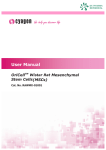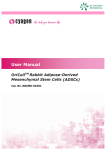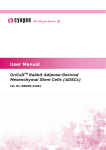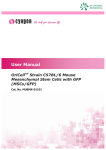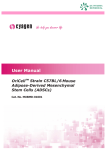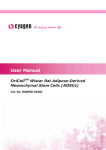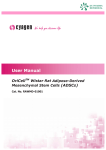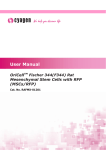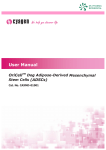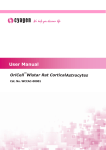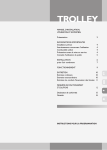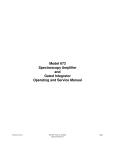Download User Manual
Transcript
User Manual OriCellTM Wistar Rat Mesenchymal Stem Cells(MSCs) Cat. No. RAWMX-01001 Table of Contents Contents and Storage ……………………………………………………………………………………… 3 Product Introduction……………………………………………………………………………………… 3 Cell Characteristics and Identity ……………………………………………………………………… 3 Product Application ………………………………………………………………………………………… 4 General Handling Principles …………………………………………………………………………… 4 Culturing OriCellTM Wistar Rat MSCs Thawing and Establishing OriCellTM Wistar Rat MSCs …………..……………………………… 4 Passaging Cyagen OriCellTM Wistar Rat MSCs ……..……………………………………………… 6 Differentiation of OriCellTM Wistar Rat MSCs ………………..……………………………………… 8 Cryopreservation of OriCellTM Wistar Rat MSCs ……………..…………………………………… 12 Appendix …………………………………………………………………….…………… 13 Troubleshooting …………………………………………………………………………………………… 13 Related Products ………………………………………………………………………………………… 14 References ……………………………………………………………………………………………… 14 Technical Support ……………………………..……………………………………… 15 CONTENTS AND STORAGE Product Name Wistar Rat Mesenchymal Stem Cells Catalog No. RAWMX‐01001 Amount per Vial 1×106 Cells Cryopreserved At Second Passage Storage Condition Liquid Nitrogen CAUTION: Please handle this product as a potentially biohazardous material. This product contains dimethyl sulfoxide (DMSO), a hazardous material, in the freezing medium. PRODUCT INTRODUCTION Mesenchymal stem cells (MSCs) are multipotent stem cells that can differentiate into a variety of cell types including osteocytes, adipocytes, and chondrocytes. MSCs proliferate quickly and are capable of generating a local immunosuppressive microenvironment, thus contributing to their wide application potentials in tissue engineering, cell therapy, and gene therapy. OriCellTM Wistar Rat Mesenchymal Stem Cells are derived from the bone marrow of Wistar Rats. They have a strong capacity for self-renewal while maintaining their multipotency. In addition, these cells have been tested for: • Exogenous Factors: bacterial/fungal contamination, mycoplasma contamination, and endotoxin contamination. • Characteristics: post-thaw viability, cell cycle, verification of undifferentiated state, and differentiation potential. This product is intended for laboratory research use only. It is not intended for diagnostic, therapeutic, clinical, household, or any other applications. CELL CHARACTERISTICS AND IDENTITY • Strong capacity to expand. Can be passaged at least 5 times. • Multipotent differentiation ability along the osteogenic, chondrogenic, and adipogenic lineages. IMPI0057A2 RAWMX‐01001 Page 3 of 15 • Posittive for CD2 29, CD44, a and CD90 (> ( 70%), and a negativ ve for CD34 4 and CD45 5 and CD11 1b (< 5%) in flow cytometry ass says. PRODUC CT APPL LICATIO ONS W Wistar Rat MSCs M have become b ap popular research targe et due to th heir potentiial use in re egenerative e medicine and a tissue engineering (in areas such as ca ardiovascula ar, neural, an nd orthoped dic disease). star Rat MS SCs can be used as cell models to o evaluate the immun noreactions,, OriCellTM Wis n of MSCs both b in vivo o and in vittro. prroliferation,, immigration, and diffferentiation GENERA AL HAND DLING PRINCIP P PLES 1.. Aseptic handling h of the producct is necess sary througho out. 2.. Once the e cells have been estab blished, alw ways freeze e several vi als of OriCe ellTM Wistarr Rat MSCs s as a back kup. Note: The O OriCellTM Wis star Rat MS SCs can be frozen/tha awed at lea ast one time e. N ecommende ed to use ce ells that are e at, or und der, an 3.. For all studies, it is strongly re p number of 10 0. original passage 4.. For general mainten nance of ce ells, we reco ommend th he seeding density to be 2.02 c . 3.0×104cells/cm 5.. For general mainten nance of ce ells, we reco ommend th hat the med dium is cha anged if it e pH indicattor in the medium m app pears yellow w). In general, becomes acidic (the very three days. d change the growth medium ev 6.. Do not le et OriCellTM Wistar Ratt MSCs overrgrow as it will result iin contact inhibition. i When the e cells are 80-90% 8 co onfluent, subculturing the cells is strongly recomme ended. Note: We sttrongly reco ommend th he use of Or riCellTM cult ture media and other related N re eagents for optimal re esults. THAWIN NG AND D ESTABLISHIN G OriCe ellTM WIS STAR RA AT MSCs s M Materials Required R • OriCellTM Mesenchym mal Stem C Cell Growth Medium (C Cat. No. GU UXMX-9001 11) Th hawing and a Estab blishing W Wistar Ratt MSCs IMPI0057A2 RAWMX‐01001 1 Page 4 of 1 15 1. Pre-warm m the fully supplemen nted (compllete) OriCellTM MSC Grrowth Medium to 37°C C. 2. Add 9 mL L of OriCellTM MSC Gro owth Mediu um to a 15 mL conical tube. 3. Remove the cryovia al of OriCelllTM Wistar Rat R MSCs frrom liquid n nitrogen. 4. t the via al in a 37°C C water batth until the last ice cry ystal disapp pears. Quickly thaw For optim mal results, be sure to o finish the thawing prrocedure wiithin 3 minutes. Be careful not to subm merge the en ntire vial. Maximum cell c viability y is depend dent on d and complete thawin ng of frozen n cells. the rapid ess than op ptimal if the e cells are thawed t forr more than n 3 minutes s. Note: Resultts will be le N 5. As soon as a the cells s are complletely thawed, disinfec ct the outsiide of the cryovial c with 70% % v/v ethan nol. 6. TM Use a pip pette to transfer the ccells to the 15 mL coniical tube co ontaining OriCell O MSC Growth Medium m inside a biosafety cabinet. c Be e careful no ot to introdu uce any d the transfer prrocess. bubbles during 7. Rinse the e vial with 1 mL of the e medium to t reduce cell loss. Su ubsequently y transfer this 1 mL L of cell sus spension in nto the conical tube. 8. Gently mix m the cell suspension n by slowly pipetting up u and dow wn. Be care eful not to introduce e any bubbles. 9. Centrifug ge the cell suspension s at 250 x g for 5 minu utes. 0. Carefully y aspirate off as much of the supernatant as s possible a and add 2-3 3 mL of 10 fresh OriCellTM MSC Growth Me edium (pre-warmed to o 37°C). 11 1. Gently re esuspend th he cells in O OriCellTM MS SC Growth Medium. 12 2. Seed the e cells into a T25 flask k and add a sufficient amount a of OriCellTM MSC M Growth h Medium. Gently roc ck the cultu ure flask to o evenly dis stribute the e cells. 13 3. Incubate e the flask at a 37°C ins ide a 5% CO C 2 humidiffied incubattor. 14 4. The nextt day, chang ge the med dium with fresh growth medium (pre-warmed to 37°C C). 15 5. Change the t growth medium ev very three days thereafter. 16 6. When the e cells are approximattely 80-90% % confluent, they can n be dissociated with Trypsin-E EDTA and passaged. p Note: Chang ging Mediium N 1.. Warm an n appropriatte amount of medium to 37°C in a sterile co ontainer. Replace R the spentt medium with w the pre e-warmed, fresh medium. Once completed d, return th he flask to the t incubattor. 2.. Avoid rep peated war rming and c cooling of the medium m. If the en ntire conten nt is not needed fo or a single procedure,, transfer only o the req quired volu me to a ste erile secondarry container. IMPI0057A2 RAWMX‐01001 1 Page 5 of 1 15 Fig. 1. OriCellTM Wistar Rat Mesenchymal Stem Cells are established. PASSAGING OriCellTM WISTAR RAT MSCs Materials Required • 0.25%Trypsin-0.04%EDTA (Cat. No. TEDTA-10001) • Phosphate-Buffered Saline (1×PBS) (Cat. No. PBS-10001) • OriCellTM Wistar Rat Mesenchymal Stem Cells (Cat. No. RAWMX-01001) • OriCellTM Mesenchymal Stem Cell Growth Medium (Cat. No. GUXMX-90011) Passaging OriCellTM Wistar Rat MSCs 1. Pre-warm the OriCellTM MSC Growth Medium, 1×PBS, and Trypsin-EDTA solution to 37°C. 2. Carefully aspirate the spent medium from the 80-90% confluent monolayer of MSCs. 3. Add 1×PBS (6 mL for T75 flask, 3 mL for T25 flask). Be careful not to disturb the monolayer. Gently rock the flask back and forth to rinse the monolayer. 4. Aspirate 1×PBS off and discard. 5. Repeat steps 3-4 two or three times. 6. Add 0.25%Trypsin-0.04%EDTA solution (2-3 mL for T75 flask, 1 mL for T25 flask). Gently rock the flask back and forth to ensure that the entire monolayer is covered with the Trypsin-EDTA solution. Allow trypsinization to continue until the majority of the cells (approximately 80%) are rounded up. At this point, gently tap the side of the flask to release the majority of cells from the culture flask surface. Important: Avoid leaving cells exposed to the trypsin longer than necessary (no more than two minutes if using Cyagen’s trypsin-EDTA solution). Care should also be taken that the cells are not forced to detach prematurely as this may result in clumping. 7. After the cells are visibly detached, immediately add the pre-warmed OriCellTM MSC Growth Medium (6 mL for T75 flask, 3 mL for T25 flask) to neutralize the IMPI0057A2 RAWMX‐01001 Page 6 of 15 trypsiniza ation. 8.. Gently piipette the medium m ove er the cells to dislodge e and resusspend the cells. c Repeat 5-6 times un ntil all the ccells are dis ssociated frrom the fla ask and eve enly d into a single cell susspension. dispersed 9.. Transfer the dissocia ated cells in nto a 15 mL m conical tu ube. 10 0. Centrifug ge at 250 x g for 5 min nutes. 11 1. Carefully aspirate off as much of the supe ernatant as s possible. T MSC Gro 12 2. Add 2 mL L of OriCellTM owth Mediu um to the co onical tube e and gently y resuspend d the cells thoroughly y. 13 3. Plate the cells into appropriate a e flasks. OriCellTM Wis star Rat MS SCs can be split at 1:2 2 e ratios. or other appropriate 14 4. Add an appropriate amount off medium to o the cells. Incubate tthe cells att 37°C 5 CO2 hu umidified in cubator. inside a 5% N Note: Care should be taken t to av void introdu ucing bubbles during pipetting. Additional Tips Tiime to Cha ange Mediium It is recommended to change the culture me edium if the ere are too many dead d cells aftter passaging. It is recommended to change the culture me edium when never the m medium bec comes i the cells do not reacch 80-90% % confluency y. The pH iindicator in n the acidic, even if um will app pear yellow w when acid dic. culture mediu bculture Tiime to Sub W When OriCelllTM Wistar Rat R MSCs a are 80-90% % confluentt, it is reco ommended that th he cells be subcultured d. Do not let the cells s overgrow as it will re esult in con ntact inhibition. Passsage 3 at 40x TM Fig.2 Image es of OriCell Passa age 3 at 100x Wistar Rat Mesenchymal M Stem S Cells at passage 3. IMPI0057A2 RAWMX‐01001 1 Page 7 of 1 15 OriCellTTM WISTA AR RAT MSC DI IFFEREN NTIATIO ON USIN NG OriCe ellTM DIFFER RENTIAT TION ME EDIA star Rat MS SCs can diffferentiate in nto a varietty of cell ty ypes including OriCellTM Wis steocytes, adipocytes, a , and chond drocytes. os O Osteogenic Differen ntiation Materials Required R M senchymal Stem Cell O c Differentia ation Mediu um (Cat. No o. Osteogenic OriCellTM Mes UXMX-9002 21) GU Osteogenes sis Protoco ol Note: The protocol listed below iss for 6-welll tissue cultture platess. N M Wistar Ra at MSCs in OriCellTM Mesenchyma al Stem Cell Growth 1.. Culture the OriCellTM a 37°C in a 5% CO2 humidified incubator. Medium at 2.. When cellls are apprroximately 80-90% co onfluent, they can be d d with dissociated 0.25%Try ypsin-0.04% %EDTA (Ca at. No. TED DTA-10001). 2 in 3.. Reseed the MSCs in n the growtth medium at 3×104 cells/cm c n a 6-well tissue p pre-co oated with 0 0.1% gelatin solution.. culture plate 4.. Incubate e the cells at a 37°C insiide a 5% CO2 humidiffied incubattor. 5.. When cellls are apprroximately 60-70% co onfluent, ca arefully asp pirate off the growth medium from each well and ad dd 2 mL of OriCellTM Mesenchyma M ell al Stem Ce nic Differentiation Med dium. Osteogen 6.. Feed cells every thrree days forr 2-4 weeks by completely replaccing the medium with h CellTM Mese enchymal S Stem Cell Osteogenic O Differentiat D tion Medium m (prefresh OriC warmed to t 37°C). 7.. After 2-4 4 weeks of differentiat d ion, cells ca an be fixed and staine ed with aliz zarin red S. event osteoblasts from m detaching g, it is recommended tto change half h of the No ote: To pre me edium everry two days s before ana alysis. d S Stainin ng Analysiis Allizarin Red 1. After the e cells have differentia ated, remov ve the osteo ogenic diffe erentiation medium from the wells and rinse with 1x phospha ate-buffered saline (PB BS). Fix ce ells with 2 mL of 4% % formaldehyde solutiion for 30 minutes. m 2. Rinse we ells twice with 1x PBS.. Stain the cells with 1 mL alizarrin red S working solution for f 3-5 min nutes. 3. Rinse we ells 2-3 time es with 1x PBS. 4. Cells can n now be vis sualized an nd analyzed d under a microscope. m IMPI0057A2 RAWMX‐01001 1 Page 8 of 1 15 T F Fig. 3 OriCellTM ed with alizarrin red S. Wistar Rat MSCs are diffferentiated intto osteocytes and are staine Adipogenic Differen ntiation Materials Required R M senchymal Stem Cell A Adipogenic c Differentia ation Mediu um (Cat. No o. OriCellTM Mes UXMX-9003 31) GU Ad dipogenes sis Protoco ol Note: The protocol listed below iss for 6-welll tissue cultture platess. N 1.. Culture the t OriCellTM Wistar Ra at MSCs in the OriCellTM Mesench hymal Stem m Cell Growth Medium M at 37°C 3 in a 5 5% CO2 humidified inc cubator. 2.. When cells are apprroximately 80-90% co onfluent, th hey can be dissociated d with EDTA (Cat. No. TEDTA A-1000). Trypsin-E 4 3.. Reseed the MSCs in n growth m edium at 2x10 2 cells/cm2 in a 6--well tissue e culture m volume o of 2 mL perr well. plate with a medium 4.. Incubate e the cells at a 37°C in a 5% CO2 humidified h incubator. 5.. Feed the cells every y three day ys until they y are 100% % confluent or post-confluent. Induction n of adipoge enic differe entiation at post-confluency is strrongly reco ommended.. 6.. When the e cells are 100% conffluent or po ost-confluen nt, carefully y aspirate off o the spent gro owth mediu um from the e wells and d add 2 mL of OriCellTMM Mesenchy ymal Stem Cell Adipogenic Differentiation medium A (induction medium) per well. 7.. Three days later, ch hange the m medium to OriCellTM Mesenchyma M al Stem Cell nic Differentiation med dium B (ma aintenance medium) b by complete ely Adipogen replacing g the spent medium A . 8.. 24 hours later, chan nge the me edium back to MSC Ad dipogenic D Differentiatio on medium m A. 9.. To optimally differentiate MSC Cs into adipo ogenic cells s, repeat th he cycle of induction ntenance att least three e times. and main M 10 0. After thre ee to five cycles of ind duction and d maintenance, culture e the cells in OriCellTM Mesenchy ymal Stem Cell Adipog genic Differentiation medium m B ffor an addittional 4-7 IMPI0057A2 RAWMX‐01001 1 Page 9 of 1 15 days until the lipid droplets are big, round enough. During these days period, change the medium every three days. Oil Red O Stain Analysis 1. After the cells have differentiated, remove the MSC maintenance medium from the wells and rinse with 1x phosphate-buffered saline (PBS). Fix cells with 2 mL of 4% formaldehyde solution for 30 minutes. 2. Rinse wells twice with 1x PBS and stain cells with 1 mL of oil red O working solution (3:2 dilution with distilled water and filter with filter paper) for 30 minutes. 3. Rinse wells 2-3 times with 1x PBS. 4. Cells can now be visualized and analyzed under a microscope. TM Fig.4 OriCell Wistar Rat MSCs are differentiated into adipocytes and are stained with oil red O. Chondrogenic Differentiation Materials Required OriCellTM Mesenchymal Stem Cell Chondrogenic Differentiation Medium (Cat. No. GUXMX-90041) Chondrogenesis Protocol 1. Calculate the total number of MSC pellet cultures required for your experiment (2.5×105 MSCs are needed to form each chondrogenic pellet). Transfer this amount of cells into an appropriate culture tube. 2. Wash the MSCs with Incomplete Chondrogenic Medium. Centrifuge the cells at 150 x g for 5 minutes at room temperature and then aspirate off the supernatant. Resuspend the cells in 1 mL of Incomplete Chondrogenic Medium per 7.5×105 cells. Centrifuge again at 150 x g for 5 minutes and then aspirate off the medium. 3. Resuspend the MSCs in Complete Chondrogenic medium to a concentration of 5.0×105 cells/mL. 4. Aliquot 0.5 mL (2.5×105 cells) of the cell suspension into 15 mL polypropylene IMPI0057A2 RAWMX‐01001 Page 10 of 15 culture tu ubes. Centtrifuge the cells at 150 0 x g for 5 minutes att room temperature. DO NOT aspirate the supernattant or resu uspend the pellet. 5.. Loosen the caps of the tubes o one half turrn in order to allow ga as exchange, and ed atmosph here of 5% CO2. Do no ot disturb incubate the tubes at 37°C in a humidifie the pellets for 24 ho ours. 6.. Feed the e cell pelletts every 2--3 days by y completely replacing g the medium in each h tube (to avoid aspirrating the p pellets when aspirating g the medi um, attach a sterile 1t the end d of the as spirating pipette). A Add 0.5 mL L of freshly y 200μL pipette tip to d Complete Chondroge enic Medium m to each tube. t prepared 7.. After rep placing the medium, fl ick the bottom of the tube to en sure that the pellet is free floatting. Loose en the capss and return n the tubes s to the 37°°C incubato or. 8.. Chondrog genic pelletts should b e harvested d after 14-28 days in culture. Pe ellets may be forma alin-fixed an nd paraffin--embedded d for alcian blue stain analysis. e Allcian Blue Staining Procedure 1.. The tissu ue sample should s be fo ormalin-fixed and paraffin-embe edded already. 2.. Staining procedure:: a) Deparaffinize slides and hy ydrate to distilled wate er. n for 30 minutes. b) Stain in alcian blue solution c) Wash in running g tap water for 2 minu utes. e in distilled d water. d) Rinse e) Visualize under a light micrroscope and capture images for analysis. Blue B es synthesiss of proteog glycans by chondrocy ytes. staining indicate TM Fig.5 OriCell O Wista ar Rat MSCs are a differentiatted into cartila ages and are stained with w alcian blue. IMPI0057A2 R RAWMX‐01001 Page 11 of 1 15 CRYOPR RESERVA ATION OF O CELL LS USIN NG OriCe ellTM CRYOPR RESERVA ATION MEDIA M R Protein-F Free Cryoprreservation Medium (C Cat. No. NC CPF-10001) is a OriCellTM NCR use freezing g medium. Its chemically-define ed and prottein-free prrotein-free,, ready-to-u fo ormulation has h been optimized to o stem cells s and prima ary cells, th hus greatly enhancing th he viability and integrity of these cells by prrotecting th hem from da amage durring the on ne-step free eze-thaw procedure. p Unlike other conventiional freezi ng media, which re equire a slow programmed freeze e, this prod duct allows the cells to o be directly y frozen at -8 80°C. Cryopreservation ge the cultu ure medium m with fresh h growth medium m 24 h hours before freezing Note: Chang g. N 1. Collect ce ells that are e in the log garithmic growth phas se. Perform m a cell count to determin ne the viable cell dens ity. 2. Centrifug ge the cells for 3-5 mi nutes at 25 50 x g and 20°C. Rem move and discard the supernattant using a pipette. 3. Resuspen nd the cell pellet in th e OriCellTM NCR Protein-Free Cry yopreservation Medium m at a cell density d of 10 1 5-106 cellls/mL. 4. Dispense e aliquots of the cell su uspension into cryogenic storage e vials that are properly labeled. 5. Place the e vials direc ctly in a -80 0°C freezerr. After 24 hours, tran nsfer the fro ozen vials to liquid nitrogen fo or long-term m preservattion. IMPI0057A2 R RAWMX‐01001 Page 12 of 1 15 APPENDIX Troubleshooting The table below lists some potential problems and solutions for culturing MSCs. Problem Low cell recovery rate Cause Solution The storage condition does not meet the requirements Purchase a replacement and store in liquid nitrogen for long‐term preservation. Thawing of the cells takes too long Thaw cells for no more than 3 minutes. Cells are incompletely recovered after thawing After aspirating off medium, wash the tube with culture medium twice and transfer all of the cells to the dish. Cells are handled roughly Care should be taken to avoid introducing bubbles during pipetting. Also avoid vortexing and high‐speed centrifugation Medium is not pre‐warmed Warm medium to 37°C before recovery. Mycoplasma contamination Discard the cells in question and disinfect the laboratory environment before recovering the next batch of cells. Slow cell growth Over digestion Wash the cells with PBS 2‐3 times to remove serum prior to trypsinization (serum will inhibit the function of trypsin). Control the digestion time. Cell aging Plating density is too low Increase the plating density. Inappropriate serum and medium Use Cyagen tailor‐made culture media. If other serum and media products are used, please perform validation to ensure compatibility. Dead cells are not removed promptly Change the medium next day after recovery to ensure removal of all dead cells. Cell Contamination Discard the cells in question and disinfect the laboratory environment before recovering the next batch of cells. Plating density is too low Some stem cells can secrete factors to support cell growth. Therefore, a certain degree of plating density must be maintained; otherwise, it will lead to cell proliferation slow down and cell aging. IMPI0057A2 RAWMX‐01001 Page 13 of 15 Over digestion Cell aging Control the digestion time. The passaging time is not appropriate The cells should be subcultured when reaching 80‐90% confluency in order to avoid contact inhibition. DMSO is not completely removed during cell recovery Wash the cells with pre‐warmed medium 2‐3 times during recovery. Differentiation reagents need to be optimized Cell passage is too high Use Cyagen tailor‐made differentiation media. Use cells at a low original passage number. Wash the cells with PBS 2‐3 times to remove serum prior to trypsinization (serum will inhibit the function of trypsin). Cells show spontaneous differentiation Ineffective induction of cell differentiation Related Products Product Catalog Number OriCellTM Mesenchymal Stem Cell Growth Medium GUXMX-90011 OriCellTM Mesenchymal Stem Cell Osteogenic Differentiation Medium GUXMX-90021 OriCellTM Mesenchymal Stem Cell Adipogenic Differentiation Medium GUXMX-90031 OriCellTM Mesenchymal Stem Cell Chondrogenic Differentiation Medium GUXMX-90041 0.25%Trypsin-0.04%EDTA TEDTA-10001 Phosphate-Buffered Saline (1xPBS) PBS-10001 OriCellTM NCR Protein-Free Cryopreservation Medium NCPF-10001 References Jiang, Yuehua, Jahagirdar, Balkrishna N, and Reinhardt, R Lee.(2002)Pluripotency of mesenchymal stem cells derived from adult marrow. Nature 418:41-49. Hideya Yoshimura, Takeshi Muneta, and Akimoto Nimura. (2006)Comparison of rat mesenchymal stem cells derived from bone marrow, synovium, periosteum, adipose tissue, and muscle. Cell and Tissue Research 327:449-462. Cyagen Biosciences reserves all rights on the technical documents of its OriCellTM cell IMPI0057A2 RAWMX‐01001 Page 14 of 15 culture products. No part of this document may be reproduced or adapted for other purposes without written permission from Cyagen Biosciences. IMPI0057A2 RAWMX‐01001 Page 15 of 15















